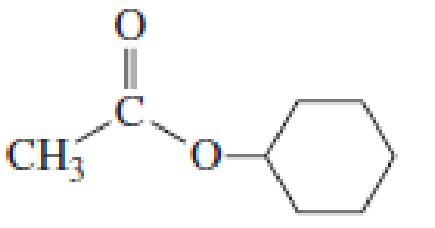
EBK ESSENTIAL ORGANIC CHEMISTRY
3rd Edition
ISBN: 8220100659461
Author: Bruice
Publisher: PEARSON
expand_more
expand_more
format_list_bulleted
Concept explainers
Textbook Question
Chapter 11, Problem 38P
- a. List the following esters in order of decreasing reactivity in the first slow step of a nucleophilic acyl substitution reaction (formation of the tetrahedral intermediate).
- b. List the same esters in order of decreasing reactivity in the second slow step of a nucleophilic acyl substitution reaction (collapse of the tetrahedral intermediate).



Expert Solution & Answer
Want to see the full answer?
Check out a sample textbook solution
Students have asked these similar questions
What is the major difference between the base-catalyzed and acid-catalyzed processes for nucleophilic addition of water to aldehydes and ketones?
a. The base-catalyzed reaction takes place rapidly because hydroxide ion is a much better nucleophile than neutral water.
b. The rate of reaction in base catalyzed process is slower than acid catalyzed process.
c. The acid-catalyzed reaction takes place rapidly because the protonated carbonyl compound is a much better electrophile than the neutral compound.
d. Only 1 and 3 are correct.
1) The first mechanistic step of an acid catalyzed nucleophilic addition to a
polar pi bond when the nucleophile is weak is which of the following?
a. A nucleophile addition
b. A proton transfer to the nucleophile
c. A proton transfer from the nucleophile
d. A proton transfer to the carbonyl
e. A proton transfer from the carbonyl
What is the first step in the general mechanism for electrophilic aromatic substitution?
a. aromatic ring protonation
b.loss of the electrophilic aromatic ring
c. deprotonation of the aromatic ring
d.addition of the electrophilic to the aromatic ring.
Chapter 11 Solutions
EBK ESSENTIAL ORGANIC CHEMISTRY
Ch. 11.1 - The aromas of many flowers and fruits are due to...Ch. 11.1 - Name the following compounds:Ch. 11.1 - Prob. 3PCh. 11.2 - Prob. 4PCh. 11.2 - Prob. 5PCh. 11.4 - a. What is the product of the reaction of acetyl...Ch. 11.4 - Prob. 7PCh. 11.5 - Using the pKa values listed in Table 11.1, predict...Ch. 11.6 - Starting with acetyl chloride, what neutral...Ch. 11.6 - Prob. 10P
Ch. 11.7 - Prob. 11PCh. 11.8 - Prob. 13PCh. 11.8 - Using the mechanism for the acidcatalyzed...Ch. 11.8 - Prob. 15PCh. 11.8 - Prob. 16PCh. 11.8 - Prob. 17PCh. 11.9 - Prob. 18PCh. 11.10 - Show how each of the following esters could be...Ch. 11.11 - Which of the following reactions would lead to the...Ch. 11.12 - Prob. 22PCh. 11.12 - Prob. 23PCh. 11.13 - Prob. 24PCh. 11.13 - Prob. 25PCh. 11.14 - Prob. 26PCh. 11.14 - Prob. 27PCh. 11.14 - Prob. 28PCh. 11.15 - Prob. 29PCh. 11.15 - How would you synthesize the following compounds...Ch. 11 - Write a structure for each of the following a. N,N...Ch. 11 - Prob. 32PCh. 11 - Which ester is more reactive, methyl acetate or...Ch. 11 - What products would be formed from the reaction of...Ch. 11 - What products would be obtained from the following...Ch. 11 - Prob. 36PCh. 11 - a. Which compound would you expect to have a...Ch. 11 - a. List the following esters in order of...Ch. 11 - D. N. Kursanov, a Russian chemist, proved that the...Ch. 11 - Prob. 40PCh. 11 - Using an alcohol for one method and an alkyl...Ch. 11 - Prob. 42PCh. 11 - Prob. 44PCh. 11 - Prob. 45PCh. 11 - Prob. 46PCh. 11 - Prob. 47PCh. 11 - Prob. 48PCh. 11 - Prob. 49PCh. 11 - Show how the following compounds could be prepared...Ch. 11 - Prob. 51PCh. 11 - Prob. 52PCh. 11 - Prob. 53P
Knowledge Booster
Learn more about
Need a deep-dive on the concept behind this application? Look no further. Learn more about this topic, chemistry and related others by exploring similar questions and additional content below.Similar questions
- explain why carbonyl compounds are so attractive to both nucleophiles and electrophilesarrow_forward1.does acetylsalicylic acid can hydrogen bond witha. itselfb.water2. determine the electrophilic and nucleophilic of acetylsalicylic acidarrow_forwardDraw all secondary resonance structures for benzaldehyde. a. Is the aldehyde group electron donating or electron withdrawing? b. Which position(s) on the aromatic ring are most likely to react with an electrophile? Harrow_forward
- A. Draw the products of the reaction shown below. Use wedge and dish bonds to indicate the dicarbonyl starting material of the reaction shown below. Ignore inorganic stereochemistry. Ignore inorganic byproducts. byproducts. Draw the products resulting from addition of a Grignard reagent to an aldehyde. D. Draw the products resulting from addition of a Grignard reagent to an aldehydom Use a dash or wedge bond to indicate the stereochemistry of substituents on asymmetric centers, where applicablelgnore any inorganic byproducts. Use a dash or wedge bond to indicate the stereochemistry of substituents on asymmetric centers, where applicablelgnore any inorganic byproducts. 1.00 2. NHSO HO 2.HO Select to Draw 1) PhMgCl (CHMgC CH 2) HCI/H:O ++ 1) vinylmagnesium chloride (CH=CHC 2HC/H.O Select to Edit OH Select to Edit Select to Edearrow_forward1. Rank the following according to increasing reactivity (1 - least reactive, 4 - most reactive in a nucleophilic acyl substitution reaction. Briefly explain your answer: .CI H3C H3C H3C H3C HO, Rank Explanationarrow_forwardWhich statement is incorrect? A Grignard reagent is a strong lewis base a. O b. Water and alcohol decompose Grignard reagents Oc. Grignard reagents add to the carbonylic carbon of a ketone or aldehyde Ether and THF are solvents not suited for Grignard reactions. d.arrow_forward
- What explains why many aldehydes and ketones can undergo self- condensation reactions in basic conditions? A. The alpha carbon can lose a proton and act like a nucleophile and the carbonyl carbon a an electrophile B. The alpha carbon can gain a proton and act like an electrophile and the carbonyl carbon is a nucleophile C. The oxygen of the carbonyl group can attack the carbon of the carbonyl group D. Only esters can undergo self-condensation reactionsarrow_forwarda. What reagent must be used in the preparation of an acid chloride from a carboxylic acid? b. Explain why this reagent is necessary. Why can;t you simply react the carboxylic acid with Cl-? COnsider the mechanism of the reaction in your explanation.arrow_forwardIdentify the starting materials for these target molecules. Only go back one step in the reaction – meaning cleave the target molecule and translate those - synthons into synthetic equivalents. a. b. N N Target Molecule Ph Target Moleculearrow_forward
- Draw the product that results from this nucleophilic acyl substitution reaction.arrow_forwardWhat contributes to the deactivating nature of halides inelectrophilic aromatic substitution? a. inductive effect b. octet rule c. delocalization of electron pairarrow_forwardChoose all correct statements. 1. Gilman reagents react with alkyl halides, including vinyl and aryl halides. 2. Grignard reagents react with alkyl halides, including vinyl and aryl halides. 3. Deprotonation of an alcohol group forms an oxonium intermediate. 4. Whenever a neutral nucleophile attacks, a proton transfer step follows. 5. An alcohol that is chiral at the a-carbon will undergo inversion of absolute configuration when it is converted into an alkyl tosylate. C 1 2 3 4arrow_forward
arrow_back_ios
SEE MORE QUESTIONS
arrow_forward_ios
Recommended textbooks for you
 Organic Chemistry: A Guided InquiryChemistryISBN:9780618974122Author:Andrei StraumanisPublisher:Cengage Learning
Organic Chemistry: A Guided InquiryChemistryISBN:9780618974122Author:Andrei StraumanisPublisher:Cengage Learning Organic ChemistryChemistryISBN:9781305580350Author:William H. Brown, Brent L. Iverson, Eric Anslyn, Christopher S. FootePublisher:Cengage Learning
Organic ChemistryChemistryISBN:9781305580350Author:William H. Brown, Brent L. Iverson, Eric Anslyn, Christopher S. FootePublisher:Cengage Learning

Organic Chemistry: A Guided Inquiry
Chemistry
ISBN:9780618974122
Author:Andrei Straumanis
Publisher:Cengage Learning

Organic Chemistry
Chemistry
ISBN:9781305580350
Author:William H. Brown, Brent L. Iverson, Eric Anslyn, Christopher S. Foote
Publisher:Cengage Learning
Characteristic Reactions of Benzene and Phenols; Author: Linda Hanson;https://www.youtube.com/watch?v=tjEqEjDd87E;License: Standard YouTube License, CC-BY
An Overview of Aldehydes and Ketones: Crash Course Organic Chemistry #27; Author: Crash Course;https://www.youtube.com/watch?v=-fBPX-4kFlw;License: Standard Youtube License